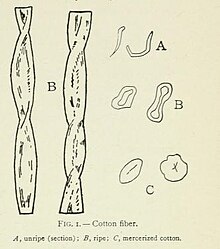
Dead cotton (Coton mort)[1] is immature cotton or underdeveloped cotton that has poor dye affinity and appears as white specks on a dyed fabric.[2][3] Daniel Koechlin (1785–1871), who was a manufacturer and a chemist in Mulhouse, established the fact in 1848 that it is dead cotton fibers that resist dye. Other chemists such as Walter Crum, Albin Haller, and Herzog explored and contributed to the subject further. Crum discovered that dead fibers have very thin cell walls.[2][4]
- ^ Crum, Walter (1849-11-01). "XLII. On a peculiar fibre of cotton which is incapable of being dyed". The London, Edinburgh, and Dublin Philosophical Magazine and Journal of Science. 35 (237): 334–338. doi:10.1080/14786444908562699. ISSN 1941-5966. Archived from the original on 2022-04-22. Retrieved 2022-03-27.
- ^ a b Crum, Walter (1863). On the cotton fibre and on the manner in which it unites with colouring matter. Getty Research Institute. Glasgow : Bell & Bain. p. 11.
- ^ Fairchild's dictionary of textiles. New York: Fairchild Publications. 1959. pp. 279, 137.
- ^ Clegg, Gladys G.; Harland, Sydney Cross (1923). "IX.—NEPS IN COTTON FABRICS AND THEIR RESISTANCE TO DYEING AND PRINTING". Journal of the Textile Institute Transactions. 14 (5): T125–T132. doi:10.1080/19447022308661242. Archived from the original on 2022-03-27. Retrieved 2022-03-27.